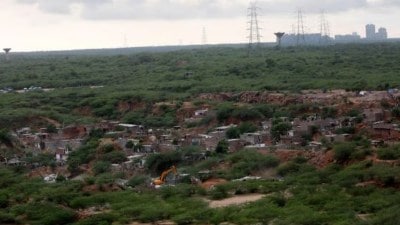Contesting the Sunni Central Wakf Board’s claim that a 50-metre wall discovered during excavations by the Archeological Survey of India (ASI) in Ayodhya was part of an idgah, the counsel for Ramlalla Virajman, the deity of Ayodhya, on Tuesday asked whether the Board is saying that an idgah was demolished to make way for the Babri Masjid.
The counsel also said that the Muslim side had tried to drag the case, asking a witness during trial questions such as “where was the labour room where Ram was born?”

“Is it their case that the idgah was demolished to build Babri Masjid,” senior advocate C S Vaidyanathan, appearing for Ramlalla, told a bench headed by Chief Justice of India Ranjan Gogoi.
The bench, also comprising Justices S A Bobde, D Y Chandrachud, Ashok Bhushan and S Abdul Nazeer, is hearing appeals against the September 30, 2010 judgment of Allahabad High Court, which ordered a three-way division of the disputed area.
Vaidyanathan submitted that he was asking this since the Board had not contended anytime earlier that there was any structure beneath the Babri Masjid, and that it was built on vacant land. In contrast, Ramlalla’s 1989 suit had said that a temple was demolished to build the mosque, he said.
The submission invited sharp reactions from senior counsel Rajeev Dhavan, appearing for the Muslim side, who said, “The question of the idgah could only have arisen after the ASI dig.”
But Vaidyanathan continued and said “Muslims changed their stand” when they realised that a wall had been found as the ASI investigation progressed. He contended that not one witness “had spoken about an idgah”, and added that it was mentioned first by three archeologists produced by the Muslim side.
Story continues below this ad
Vaidyanathan said idgahs are built in areas away from local habitation, while the Ramkot area, where the wall was discovered, was “full of habitation”.
The senior counsel said the ASI report also mentioned presence of 28 other walls, some running perpendicular to the 50-metre wall. This, he said, indicated that it may have been walls of rooms or halls, etc.
But Dhavan and senior advocate Meenakshi Arora, also representing the Muslim parties, objected and said the ASI had not excavated the other walls, and that these did not join the 50-metre wall.
Justice Bobde then asked Dhavan to submit a drawing which show parts, if any, joined to the wall and those which were not.
Story continues below this ad
Vaidyanathan said it is “unfortunate” that the Muslim side is criticising the ASI. He said ASI’s experts are invited even to Thailand and Cambodia, where they do a “commendable job”.
Arora had sought to compare archeology with the opinion of handwriting experts. On this, Vaidyanathan said the comparison showed “erroneous appreciation of knowledge required in archeology”.

 The counsel also said that the Muslim side had tried to drag the case, asking a witness during trial questions such as “where was the labour room where Ram was born?” (Express file)
The counsel also said that the Muslim side had tried to drag the case, asking a witness during trial questions such as “where was the labour room where Ram was born?” (Express file)






